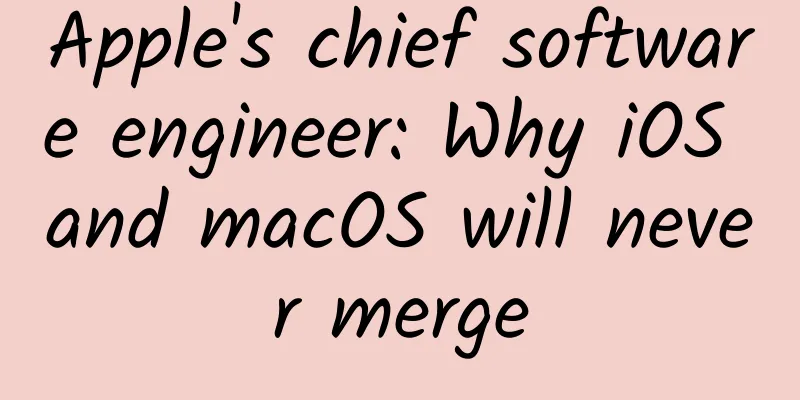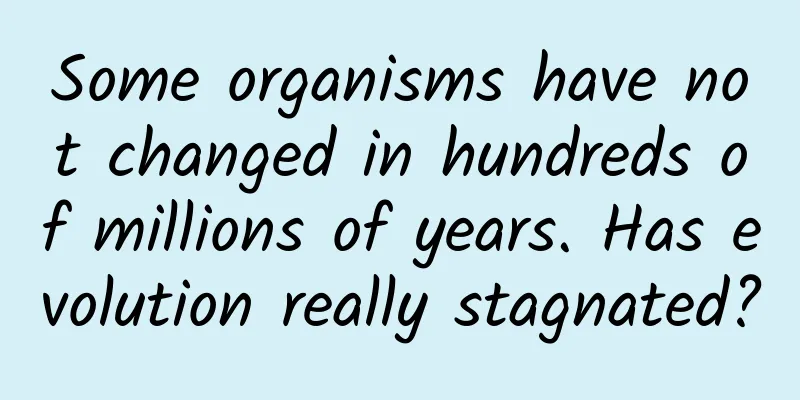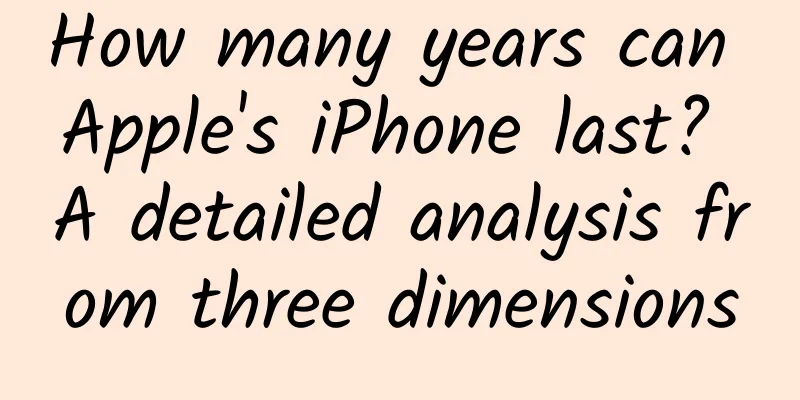Apple's chief software engineer: Why iOS and macOS will never merge

|
On June 4, 2018, Apple held its annual WWDC developer conference. At this conference, Apple did not release any hardware, but updated iOS/macOS/tvOS/WatchOS and other systems, and firmly denied the rumors about the merger of iOS and macOS. In response to this situation, Wired magazine conducted an exclusive interview with Apple Senior Vice President Craig Federighi to explore Apple's considerations behind WWDC 2018; Leifeng.com compiled this article without changing the original meaning. Yesterday at WWDC, Apple was very soft throughout. At the end of the keynote, it was the turn of Apple's senior vice president of software engineering, Craig Federighi, to speak on stage. He started by talking about a problem that many people are eagerly waiting for Apple to develop an operating system that integrates the iPhone and the Mac. Unfortunately, Federighi gave a "No" answer to the question, and he directly displayed it on the big screen behind him. Within a few minutes, the screenshot of this "No" became the most popular emoji on Twitter.
However, this resounding denial should actually be put in quotation marks, because although Apple has always insisted on fighting on two fronts, iOS and macOS, they have moved many iOS applications to the Mac. In an interview with Wired magazine, Federighi said that the architecture for porting iOS apps to Mac began to be developed two years ago. At the same time, he also revealed many technical details about the project and "selected" some types of iOS apps that he thought would shine on Mac. In addition, Federighi also expressed his disdain for touch-screen laptops. Double standardsIn Federighi's view, the core of the problem is not to create a unified operating system, but Apple's view on the future of applications. At the same time, he also talked about the health of the Mac App Store. Although this application store for Mac also has tens of thousands of applications, it is still quite weak compared to the App Store, which already has millions of applications. In other words, at this stage, Apple attaches more importance to the role of iOS applications in driving the development of the Mac platform rather than promoting the integration of the two operating systems. At the WWDC keynote on Tuesday morning, Apple said that some of its own native iOS apps, such as Stocks, News, Voice Memos and Home apps, will be available on the latest macOS Mojave later this year. On the surface, Apple does want to try the cross-platform route, but in fact, they have been doing it for a long time. The Silicon Valley giant has been developing related tools two years ago, and they want to help third-party developers "easily" port mobile apps to macOS. It is reported that Apple's internal software engineers have been testing such porting tools, and the four iOS apps mentioned above are the product of Apple's two years of hard testing. However, Apple is obviously not ready yet, and developers may not be able to use this set of tools until next year. This secret work of Apple has actually been exposed before. Bloomberg revealed at the end of last year that Apple is developing new solutions to help developers create cross-platform applications that can run on iOS and macOS. However, how these cross-platform applications should be developed and how they interact with them remains a mystery. After all, the experience of controlling the touch screen with fingers and the experience of controlling the Mac with a keyboard and mouse are completely different. Same mother tongueFederighi also talked about the issue of software porting from a technical perspective. In this regard, Apple is not like other manufacturers who use simulators or emulators, because their systems have their own unique advantages, that is, iOS and macOS share the same kernel, and have similar architectural layouts in graphics, audio, and display layout. However, the two platforms are not static, and their differences are increasing after years of evolution. UI kit is probably one of the most well-known architectures. It was originally tailored for iOS and is inherently incompatible with keyboard and mouse operations. However, on macOS Mojave, UI kit will be upgraded, and the spring of developers is coming. For developers, some parts of the application porting can even be completed automatically, while the rest requires a little programming skills. Using Xcode (application development tools) on the Mac platform, developers can briefly explain their ideas for developing ported macOS software, and then some interactive UIs will be automatically converted, such as turning a long press on iOS into a two-finger click on the Mac. Developers only need to make some additional designs in areas such as menus and toolbars. Even though these apps can run efficiently across platforms, Federighi still emphasized that your Mac will not be used like an iPhone. "It's still macOS, and you can still plug in an external hard drive or connect four external monitors," he said. Of course, not all mobile apps are suitable for porting to Mac, such as pedometers. However, Apple still believes that many games are very suitable for desktop. Federighi specifically mentioned Fortnite, which also uses the Metal graphics interface and is very easy to port to macOS. He also said that he had imagined adding native desktop applications for websites such as IMDB, Yelp or DirectTV to Mac, which are much more comfortable to use than browsers. For developers, making such applications for macOS is no longer a problem, it’s just that the workload is larger due to tool limitations. From the user’s perspective, if you want to attract people to use the ported applications on the desktop, you have to at least give them some sweetness, which can be special application functions or even stronger privacy protection. I also asked Federighi a question that everyone is generally concerned about: Since iPhone and Mac use different chip architectures, does this have any impact on them running the same application? "Not much." Federighi replied. "In the past few years, we have continuously optimized Apple's core APIs so that they can run smoothly even on different chip architectures." Sensitive topicsDuring the interview, I asked a lot of pointed questions, such as whether Apple's move to porting iOS apps to macOS means that it will launch a touch-screen version of the Mac. Federighi's answer was also very concise. He said that he was "not interested in touch-screen PCs and may never get involved in this field in his lifetime." "From our perspective, the best ergonomics for using a Mac is when the user has both hands on a flat surface. Raising your arm to click on the screen is tiring," Federighi said. He also said that the touch-screen notebooks on the market are all "experimental products." "Apple has never been jealous of others, and our product managers have not investigated whether Apple can replicate this concept in a short period of time." (Having said that, the Surface, the most powerful rival of the MacBook, has indeed received positive reviews from most users) The future of unitySpeaking of competition, Apple is actually lagging behind. After all, its main competitors have made a lot of achievements in cross-platform, and they all provide a lot of mobile applications that can run on laptops and desktop PCs. Microsoft launched the Universal Windows Platform (UWP) in 2016. Developers only need to write one application to run smoothly on PCs, tablets, mobile phones and Xbox One. In the same year, Google also joined the battle and brought the Google Play Store to Chromebooks, which means that the already quite cheap Chromebooks can also enjoy Android platform applications. In the development of cross-platform applications, Microsoft and Google have adopted different technical solutions, but two years of practice have reflected a problem, that is, in the context of the popularity of mobile applications, it may be a thankless task for developers to develop independent applications specifically for multiple platforms. In addition, the concept of so-called universal applications or PC-compatible mobile applications may just be wishful thinking of manufacturers. When Microsoft's UWP was just launched, some developers complained that this was Microsoft's excessive control over its own platform. Tim Sweeney, co-founder of Epic Games, even publicly pointed out that Microsoft gave developers an ultimatum, "If you want to use these Windows features, you have to obey the control of this closed UWP ecosystem." At the same time, no one can tell what universal apps mean for revenue distribution. After all, Apple now takes 30% of the App Store's revenue (15% for long-term paid apps). At present, Mac developers can still evade the "Apple tax" through online distribution channels. What about the future? Will the savvy Apple still allow developers to "evade taxes" like this? In response to this question, Federighi insisted that the distribution channels and revenue sharing ratios in the future will be determined by developers. However, all this will not be known until next year (including when developers can use the porting tools), during which time more details will continue to be exposed and developers will evaluate the value of desktop applications themselves. So, let us look forward to next year's WWDC together. |
<<: Why are developers cheap on iOS but valuable on GitHub?
Recommend
After finding the black box, how many more steps are needed to analyze the cause of the accident?
The search for the cause of the crash of China Ea...
【Practical】A complete collection of commonly used auxiliary tools for APP promotion!
Some people say that App promotion is hard work. ...
6 bedrooms, 3 living rooms, 2 bathrooms! The "cosmic Versailles" of China's space station is here
How big will China's space station be when it...
The matching method of Baidu SEM promotion keywords has been upgraded!
What is keyword matching? Just like Cupid’s arrow ...
Wearing AR glasses to assemble the Chinese space station, super cool
Not long ago, several students from Tsinghua Univ...
Two major shortcomings that no smartphone can overcome
Before the iPhone and Android were introduced, no...
Introduction to Yang Wanli: Has the ranking of optimized websites recovered?
The website optimization ranking in the second ha...
WeChat "Mini Programs" are going to kill apps? Entrepreneurs may not think so
"What is a mini program? A mini program is a...
Without Huawei Kirin, how long can Qualcomm, which continues to perform poorly on Snapdragon 8 Gen 1, continue to win?
Last year, Qualcomm released the flagship SoC Sna...
China Passenger Car Association: Narrow passenger car retail sales are expected to reach 2.05 million units in December 2021
In November, the market was affected by both chip...
Studying becomes a practical training camp, easy to pass manuscripts and turn them into cash with no basic knowledge, earning an extra 50,000+ per month
Reading becomes a practical training camp, easy t...
The actual progress report of "operating core users" has successfully completed the first step!
Every product operates core users, but also encou...
Traffic War: How do I operate e-commerce on JD.com (Part 2)
The top-level structure of traffic logic ① Accura...
At the critical moment, this article may save your life!
One minute with the doctor, the postures are cons...
A 56% plunge in China's mobile phone market in February
In response to the epidemic, the Chinese mobile p...









